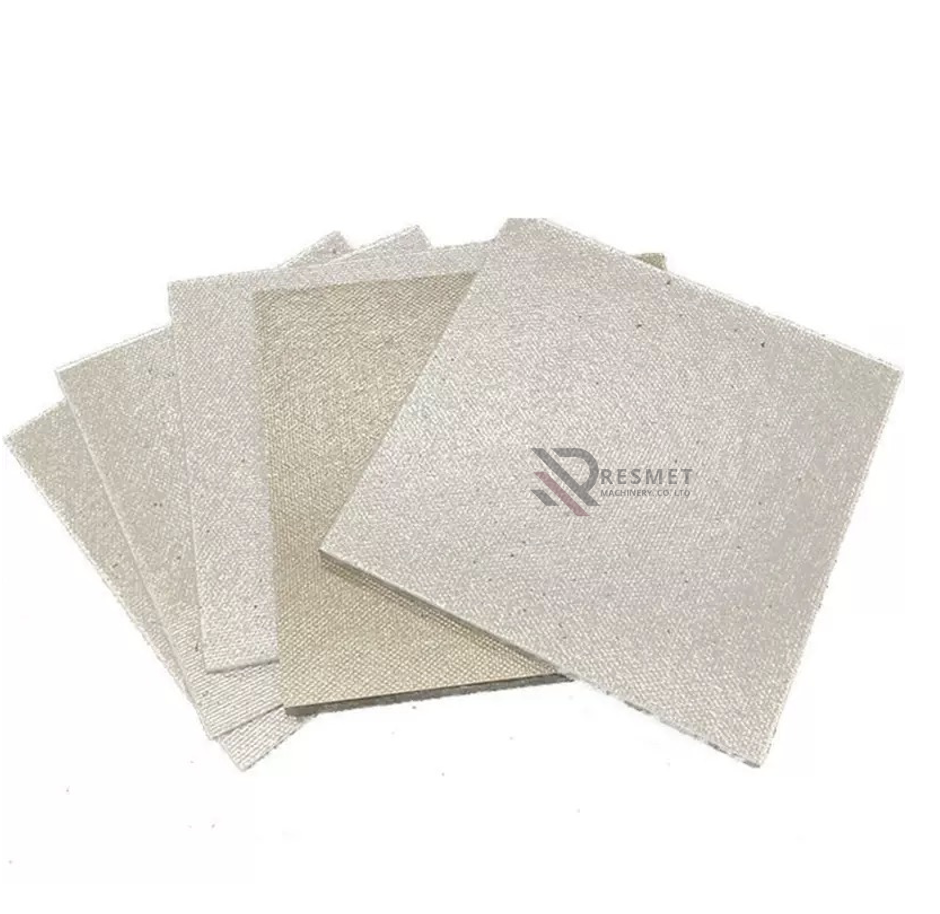
Are you looking for resistant, durable mica sheets with excellent thermal and electrical insulation capacity? At Resmet we are specialists in the manufacture and supply of muscovite mica sheets and phlogopite mica sheets, designed to meet the most demanding needs of the electrical, electronics, automotive and heating industries. Muscovite mica and phlogopite sheets are used as electrical and thermal insulation materials, but they differ in their resistance to high temperatures and their specific applications. Muscovite is a type of mica with a light and transparent color, ideal for electrical insulation, with a thermal resistance of up to approximately 700°C. Phlogopite is more resistant to heat, withstanding up to 1000°C and used for industrial insulation, such as in furnaces and aerospace and automotive applications. Both can be presented as flexible or rigid sheets, the rigid ones being formed by mica paper and resin.
• Thickness available: from 0.10 mm to 2.00 mm as standard, with special options up to 5.00 mm.
• Standard Dimensions:
• 1000 × 600 mm
• 1000 × 1200 mm
• 1000 × 2400 mm
• Custom cut: we manufacture the sheets with the exact measurements you need.
• High thermal resistance:
• Muscovite: withstands up to 800 °C.
• Phlogopite: ideal for extreme temperatures, up to 1000 °C.
• Excellent electrical insulation: perfect for applications where safety and stability are key.
• Superior durability – maintains integrity in high-demand environments.
• Versatility of use: they are used in ovens, resistors, electric motors, transformers, heating equipment and advanced electronics.
Our muscovite mica and phlogopite sheets are used in sectors such as:
• Electrical industry: insulators for high voltage equipment and resistors.
• Electronics: insulating boards, power devices and delicate components.
• Automotive: gaskets, thermal insulation and heating systems.
• High-temperature appliances: ovens, microwaves, generators, and more.
Origin and structure
• Chemical composition: KAl₂(AlSi₃O₁₀)(OH,F)₂ .
• Crystallography: belongs to the monoclinic system; it is dioctahedral.
• It has perfect basal exfoliation, which allows you to obtain extremely thin, flexible and elastic sheets.
• It is common in granites, pegmatites, gneisses and phyllites, as well as being found in the form of huge crystals useful for sheets.
Physical and mechanical properties
• Colour: colourless, white or greyish, transparent or translucent.
• Mohs hardness: approximately 2–2.5 parallel to {001}, and up to 4 perpendicular.
• Specific gravity: between 2.76 and 3.0.
• Lusters: vitreous, silky or pearly.
Functional properties and uses
• High dielectric and thermal strength; Excellent electrical and thermal insulator.
• Used as a substitute for glass in furnace windows and high-temperature equipment.
• Applications: insulators in electronic devices, transparent windows in ovens, fillers in paints and plastics, cosmetics (gloss), mold releasers, barriers in perforation, optical and medical components.
• Other properties: chemically inert, lightweight, reflective, flexible, resistant to moisture and electricity.
Specific technical properties (Mica Grade V1)
• Apparent electrical resistance: 120–200 kV/mm.
• Thermal conductivity: about 0.0013 Gcal/(s·cm²·°C/cm)
Origin and structure
• Chemical composition: KMg₃(AlSi₃O₁₀)(OH,F)₂ .
• It belongs to the trioctahedral group of biotite; monoclinic system.
• Like muscovite, it has a basal exfoliation perfect for obtaining thin sheets.
Physical and mechanical properties
• Color: brown, red, yellow, green, silver, gray.
• Specific gravity: between 2.6 and 3.2.
• Mohs hardness: 2.5–3.0.
Functional properties and uses
• Thin films are transparent, elastic, chemically inert and insulating.
• Resists higher temperatures than muscovite; it can operate between 800–1000 °C and calcinate up to about 1000 °C.
• Used in high-temperature insulation applications and for items such as "micanite" in switchgear.
• Examples of applications: insulating components in furnaces, electric motors, generators, furnace windows, etc.
Comparative technical properties
• Coefficient of expansion: higher, between 30 ×10⁻⁶ and 60 ×10⁻⁶ °C⁻¹ .
• Thermal conductivity: slightly lower, about 0.0010 Gcal/(s·cm²·°C/cm).
• Apparent dielectric strength: in the range of 115–140 kV/mm.
• Dielectric permissiveness: 5–6; tangent loss: 1–5×10⁻³; volumetric resistivity: 10¹²–10¹⁴ Ω·cm
Feature | Muscovite | Phlogopite |
Chemical copmposition | KAI2(AISi3O10) (OH, F)2 | KMg3(AISi3O10) (OH, F)2 |
Hardness (Mohs) | 2-2,5 / 4 | 2,5-3 |
Maximum Operating Temperature | 600-800 °C | 800-1000 °C |
Coefficient of thermal expansion | 9-36 x 10-6 or C-1 | 30-60 x 10-6 or C-1 |
Dielectricia | Loud | Smaller than muscovite |